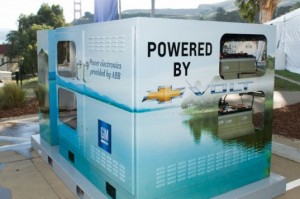Like most of the world, I’ve been watching the aftermath of Hurricane Sandy with interest and amazement. This was a storm predicted far in advance, and followed pretty much the path predicted (slightly south but close enough for weather predictions), and yet…wow, just look at the chaos it has created. People had ample time to prepare, and while I’m sure many did, news reports are full of stories of people needing food, water, gas, etc. My takeaway from all this is this:
Food. This is actually an easy one. Get freeze-dried food in cans; my choices there are Mountain House and Backpacker’s Panty. It can be a little pricey, but start stocking up now…buy a can or two a month and build up a reserve food supply that way. When you see a good sale on canned goods or dry foods like breakfast cereals, stock up…you’ll use them eventually, but if there IS a disaster, this food can last you quite a while. If you lose power, feast on ice cream and other cold perishables, for they won’t last long.
Water. I don’t believe water can be stored well long term, so my focus is on gathering, short term storage, and water safety. For gathering, educate yourself about local water sources (rivers and reservoirs, for example). For storage, you can buy water jugs, but there are other options too. We save old plastic juice bottles (wash them first) for this purpose (they also work great to fill and freeze for ice in coolers when camping). Your water heater is a huge water storage tank that you can tap into if needed (use the drain plug at the bottom). Rainwater can be collected in barrels. To treat the water, use tablets for short term use, but long term (when the tablets run out), you’ll need to boil the water to make it safe to drink.
Heat. What you do for heat really depends on where you live. Plan on having a way to stay warm enough to survive if your electricity and natural gas are not working. Solar can be good for this if your system is truly off-grid or can run on a backup power supply.
Power. Or rather, electricity. It’s not something we really NEED, but is nice to have to keep cell phones recharged, power a refrigerator, or even power some heat sources (like the electric fan and auger in a wood pellet stove). Many people buy generators for this, but then face problems when they need more gas and the gas stations are out of fuel (like what’s happening in New York these days). A solar based solution is worth considering, such as the Goal Zero Yeti system. It gives you enough power to run a refrigerator or other devices, and comes with solar panels to charge it. Another short-term option is a DC-AC inverter that you can plug into your car’s cigarette lighter to provide power to low-power devices like cell phone chargers. You’ll be draining your car battery by doing so, but if you have a full tank of gas and don’t use much electricity, this can be OK.
Gas. If you’re lucky enough to have advance warning of a natural disaster (like a hurricane heading your way), fill all your cars with gas beforehand. You won’t want to deal with the inevitable lines and crowds in the days immediately after the disaster.
Defense. In a bad disaster, emergency services will be overwhelmed. Be prepared to protect your family, for as the days go by, people will grow increasingly desperate if they haven’t prepared for this.
Remember, some people just aren’t going to take the steps needed to prepare for natural disasters. With that in mind, it would be wise to not only have enough supplies for your own family, but some to share with your neighbors in their times of need.
Global warming is real, and will increase the potential severity of storms in the future. Hurricane Sandy should be the benchmark for the new norm that everyone should be prepared for.
 When people talk about how long the batteries in hybrid and electric vehicles last, keep in mind that the battery is still usable at the end of its ‘life’, it just has decreased capacity (around 80% of its original capacity seems to be a common number there). It’d be a shame to recycle a battery with so much energy storage potential…which is why it’s nice to see things like this system from GM, designed to use the cast-aside batteries from their Volts (once they get to that age, that is…it’s still a very new car). One of the systems shown here provides enough energy storage to power three to five average homes, so a more likely use would be in an off-grid system in a larger building, for example. It’s an imperfect solution, but this is an emerging market and it’s nice to see that hybrid batteries have a good chance of finding life beyond the pavement.
When people talk about how long the batteries in hybrid and electric vehicles last, keep in mind that the battery is still usable at the end of its ‘life’, it just has decreased capacity (around 80% of its original capacity seems to be a common number there). It’d be a shame to recycle a battery with so much energy storage potential…which is why it’s nice to see things like this system from GM, designed to use the cast-aside batteries from their Volts (once they get to that age, that is…it’s still a very new car). One of the systems shown here provides enough energy storage to power three to five average homes, so a more likely use would be in an off-grid system in a larger building, for example. It’s an imperfect solution, but this is an emerging market and it’s nice to see that hybrid batteries have a good chance of finding life beyond the pavement.

